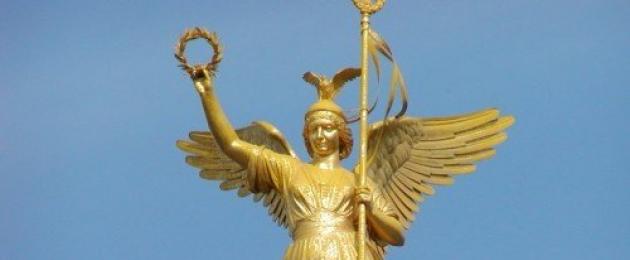Nike is the goddess of victory, the winged patroness of triumph and the eternal companion of battles. The daughter of a titan and the most influential oceanid among thousands of others. Nika accompanied not only bloody battles. Wars on the battlefield, participants in the Olympics and people of art equally needed her patronage. She was always present where the spirit of competition and inevitable victory soared. The beautiful goddess Nike will be discussed in our today's article.
History
According to legend, the parents of the goddess Nike were the fearless giant Pallas and the unpredictable oceanid Styx, the mistress of the river of the same name. Her name was personified with a monster and was the embodiment of primeval horror. Once, during the battle of the Olympian gods with the titans, Styx quickly went over to the side of the gods and asked for help from her children Kratos (strength), Zelos (anger), Bia (violence) and Nike (triumph of triumph). It was Nike who sided with Zeus, ensuring his victory and omnipotence. In gratitude, he raised her to Olympus, making her a devoted companion and right hand. Even the greatest ancient Greek sculptor Phidias, creating his famous creation, Olympian Zeus, put a figurine of the goddess in the hand of the Thunderer. Many manuscripts mentioned that Nike spent her childhood with Zeus' daughter Athena, the goddess of wisdom and just war.
What did the goddess patronize?
The goddess Nike, carrying victory on her wings, patronized any battles and competitions. Olympics, musical and drama competitions, military battles - every warrior or contestant hoped for the grace of Nike, because she was a symbol of a successful result and triumph.

Image
The goddess Nike has always been represented in a state of flight. Her gaze is directed skyward, and her wings are spread wide. This gave rise to a sense of victory and confidence among the fighters. Often, the patroness of triumph held in her hands a weapon taken from the enemy, and an olive wreath. Later, she was depicted with the staff of Hermes. It was believed that the deities are similar, both of them are messengers of the gods and harbingers of fateful events. Also, often the face of the deity was visualized as accepting gifts from the winners or hovering over their chariot.
The most famous sculptural image of the goddess is the statue of Nike of Samothrace. The marble masterpiece has survived to this day, partially preserved, without a head and hands. The beautiful and majestic figure of the goddess towered on the rocky shore of the island of Samothrace, washed by the sea. In the course of long studies, it was found that the goddess Nike stood on a pedestal resembling the stern of a ship, and blew a horn, proclaiming a solemn victory. A great admirer of the goddess, carrying victory on her wings, was the commander Alexander the Great. He dedicated every battle to her, erected temples and did not skimp on gifts. It was Macedonian who initiated the tradition of awarding the winner with an olive wreath in honor of the goddess.

Goddess today
To this day, references and statues of the goddess Nike have survived (you can see the photo in the article). Her image is often present on pennants and banners, and her name is in hymns. Even the popular sportswear firm Nike is named after her. Such ancient sculptural images as Nika of Samothrace have also been preserved. In 1879, the statue was moved to the Louvre Museum of Art in Paris, where it still adorns the Daru staircase. Despite the fact that the remains of the hands and head were never found, 23 fragments of the statue were found during the excavations. After much research, it was established that these are parts of the pedestal - the stern of the ship. All of them are also kept in the Louvre.
And today this sculpture of the goddess of victory Nike is considered mysterious and enigmatic. Many legends surround her true form and true creator, whose work even modern critics have dubbed ingenious. Someone believes that Nike's right hand held a goblet, others argue that the goddess blew a horn, proclaiming the victory of Rhodes, while others prefer to think that both hands did not exist at all. A huge number of attempts were made to recreate the original form of the sculpture, but they all turned out to be failures. For the goddess who brings victory was losing her solemn and light appearance.
In the heart of the Acropolis is the temple of the goddess Nike, which art historians consider beautiful and strange at the same time. It differs from all the buildings of Ancient Greece, destroying all the building principles of that time. This is a temple erected to the glory of Nika the Wingless. Inside the sanctuary, the figure of the goddess Nike in the attire of a warrior stands majestically. In her hands she holds a shield and a sword, and a golden helmet covers her head.

The Temple of the Goddess Nike has gone through several renovations, so it lacks a roof and several columns. However, this ancient building to this day remains one of the most beautiful sights of Athens, which can be seen from all over the city.
Soon the celestial became an icon of painters. For inspiration, great artists and creators turned to her. For example, Abbott Henderson Thayer. Fascinated by the image of Nicky, he created the famous plagiarism painting "Virgo". Also in the first half of the 19th century, the writer Phillip Tommaso Marinetti published the Futurist Manifesto. Its creator contrasted mechanics and movement with a lifeless face. And it sounds like this: "... the roaring motor of the car works like a buckshot - it is much more beautiful than the sculpture of the goddess Nike."
- In contact with 0
- Google+ 0
- OK 0
- Facebook 0








